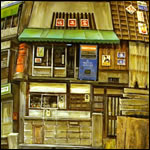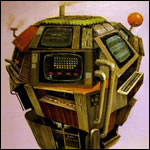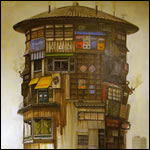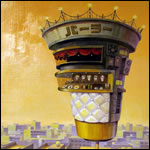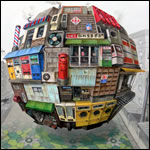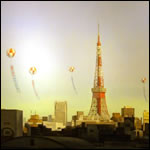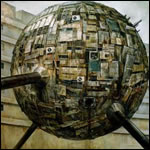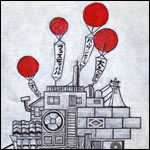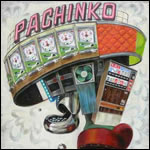Masakatsu Sashie - Japanese Artist Interview
Masakatsu Sashie is a Japanese painter from Kanazawa. His artwork first came to our attention at the Geisai Art Fair in Tokyo in 2005. Sashie's detailed paintings often feature large city-like spheres hovering above what looks like remnants of a lost or rotted human civilization. The city spheres in his work have a fantasy "old Japan" look to them - mixing elements of Japanese architecture from the post WWII period with fantasy or science fiction influence.
At the 10th Geisai in 2006, Sashie was awarded the Scout Prize by several judges - including Gallery Naruyama, East Touch, Kaiyodo, and the American magazine Giant Robot. After the show, Giant Robot did a write-up on Sashie-san in their English-language magazine. In 2007, they offered him a spot in a Japanese group art show at their Los Angeles gallery. The show will be held in September of 2007 and Sashie's works were a bit hit with Los Angeles area art fans. After the success of the show at Giant Robot, Sashie was offered a place in the Giant Robot Biennale show at the Japanese American National Museum in Los Angeles. That show is on through January 13, 2008.
Now that Sashie is making his move on the Western Art World, we thought it would be a good time to sit down with him and talk about his art, his views on the meaning of life, and other less serious subjects. Here's what Masakatsu Sashie had to say:
(Note: This interview was conducted over email, with the help of a translator.)
Horror.com: You are from Kanazawa. Is there an art "scene" like there is in Tokyo? Are there many galleries, famous artists, museums, art schools, etc? Do you think it was beneficial or detrimental to you as an artist to grow up away from Tokyo, the "center" of contemporary art in Japan?
Sashie: Kanazawa has been known for its traditional arts, and a unique, specialized art scene that derived from the traditional arts exists, but the current art scene is hardly receiving an equal amount of attention that the traditional arts do.
There are several galleries and art schools, but they greatly differ from what Tokyo has to offer. As for a museum and a college, The 21st Century Museum and my alma mater, Kanazawa College of Art, are well known. Famous artists may be secretly living here, but not that I know of.
I am what I am today because I live away from the center of contemporary art, so I'd like to consider it a plus.
Horror.com: What contemporary artists, Japanese or non-Japanese, do you think are doing amazing work these days? Do you have any favorite artists personally?
Sashie: Recently, I have been watching Damien Hirst. Personally, I like Kenji Yanobe and Yukio Oscar Oiwa.
Horror.com: What is the size of the largest painting you have made to date? Some artists create huge works, especially for museum shows. If you had the time, space, and budget, how large of a painting would you like to make?
Sashie: The largest is 181cm x 227cm. Currently, I am considering a 320cm x 160cm 2D work. If I have sufficient time, space, and budget, I would love to try something even bigger.
Horror.com: Have you ever considered working on a sculptural (3D) representation of the city spheres in your work?
Sashie: Yes, I have. If I have sufficient time, space, and budget, I would like to make one. I have recently made a small, plastic model.
Horror.com: Your older works seem to have similar themes to your newer ones - the floating spheres, for example - but the older work has less of the recognizable details of Japanese city elements. Did you make a conscious decision at some point to be more specific with the details of your works, or did these ideas just evolve?
Sashie: I have been consciously adding more details. Simply put, the world without those elements is the very world I want to express, and I consider the elements as icons that explain the world.
Horror.com: In another interview, you mention your "Balanced Aquarium" theory. Can you explain that theory and how it influences your art?
Sashie: As I explained in the other interview, the fundamental theme of my work is a "world" that functions by the phenomenon seen in the balanced aquarium. It is a limited space within which the circle of life exists. The size of the world to an individual varies depending on his imagination and determination. How would one view the world if his living space were physically limited, maybe in a container, for example, an aquarium?
Every life form, within its designated space, occupies a smaller territory. Within it, egoism and indifference toward the environment are repeated daily. Yet, it is also full of everyday tranquility and happiness. These two factors express a world, which is somewhat unstable but retains a comfortable balance.
In my work, the symbolic shape of a world, a container, or a territory is the sphere of the earth, which is made up of drawings of buildings. The theory has been influential to me in terms of drawing such limited and closed worlds.
Horror.com: Are the places in your paintings imagined, or are they specific cities in Japan?
Sashie: Mainly they are modeled after the town I grew up in.
Horror.com: Some of your works seem to touch on the themes of destruction and abandonment. Do you consider yourself an optimist or a pessimist?
Sashie: If the choices are only between those two, I think I am a pessimist.
Horror.com: Your work doesn't seem to include any human figures, but most of the objects that you paint are man-made. Is it intentional on your part - to avoid painting mankind or nature?
Sashie: Yes, it is intentional. I feel that human figures in a work of art automatically determine the time, the space, and the world. Even worse, they may determine the way the viewers view the work. I do not wish to do so. My aim is to have the viewer imagine human beings from artificial objects, and to be aware of nature for the lack of it.
Horror.com: In Tokyo, like many other parts of the world, development seems to take priority over preserving history. Buildings that have survived the war - or that were built right after the war - are torn down without a thought to build a new huge glass shopping mall filled with international brand shops. Do you find that sad? Do you think more effort should be put into preserving Japan's history?
Sashie: Japan has a history of constantly changing itself and its values upon receiving foreign influence. Japanese have unique adaptability, and often are receptive to change. I feel that the trend is another example of Japanese adaptability, and view these changes as interesting. Of course, what needs to be preserved should be preserved, and we must all learn to discriminate.
Horror.com: Has progress - electricity, cars, airplanes, computers, etc. - been a good or bad thing for mankind?
Sashie: This is my own opinion; I consider the development of technology is a duty given to intelligent life forms. The process of completely parting from the natural environment and reaching the level of not influencing the earth's environment may cause many negative effects. Will the result be good or bad, we won't know for a long time to come.
Horror.com: You were involved in the Fishmans art show at Nanzuka Underground a few years ago. Does music influence your art?
Sashie: Yes, it does greatly. The spatial image of music and its elapse have given me inspiration.
Horror.com: The subject matter of your work is very Japanese. How have non-Japanese people reacted when they view your work? Do older Japanese people react to your work differently than younger Japanese?
Sashie: I receive great responses from foreigners. I feel that the reactions are somewhat different, though both favorable, between younger and older generations, but nonetheless my works seem to be received well.
Horror.com: You had a show at the Giant Robot space in Los Angeles a few months ago. Was that your first show in America? Are you interested in the idea of showing your work outside of Japan?
Sashie: Yes, it was the first time. I hope to make that show an opportunity to start showing my work internationally more.
Horror.com: Any final words for our readers?
Sashie: If my show comes to your town, please visit it and see my work.
We appreciate that Masakatsu Sashie took the time to answer our questions. If you want to see more of his work and find out the latest news about his upcoming shows, please visit his website.
Related Links:
- Masakatsu Sashie Official Website
- Giant Robot Biennale show at JAMN
- Giant Robot Magazine
- Geisai Art Fair
Related Horror.com Articles:





